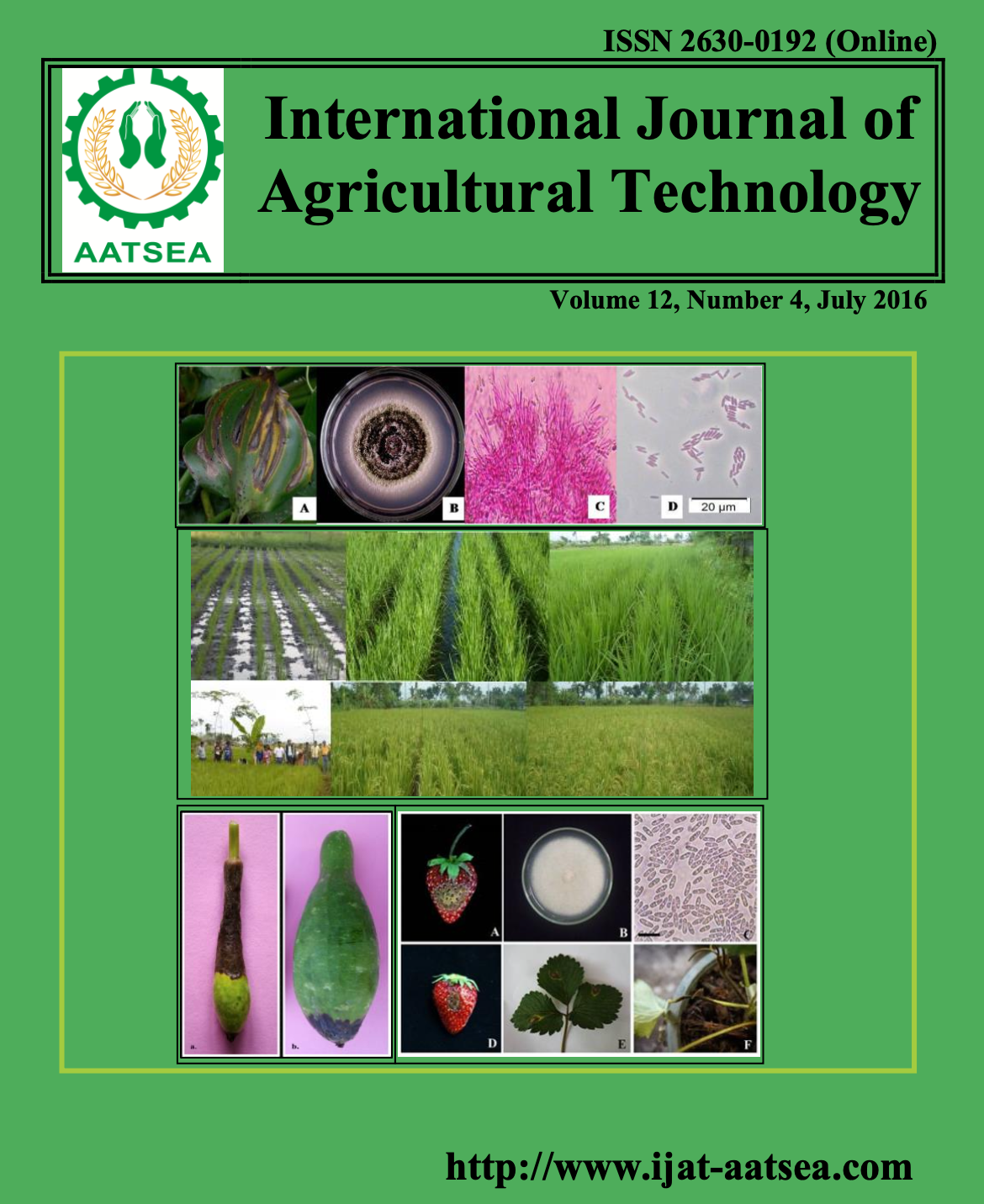Isolation and identification of indigeneous microbial bioagents strains from Meghalaya and In vitro evaluation of the antagonistic properties against common fungal phytopathogens
Main Article Content
Abstract
A study was conducted to evaluate the antagonistic properties of known microbial bio-agent strains isolated from Meghalaya. Strains of known bio-agents such as Bacillus subtilis, Pseudomonas fluorescens, Trichoderma harzianum and Trichoderma viride were isolated from different agricultural practices. These isolates were tested for antagonism against several fungal plant pathogens such as Alternaria brassicicola, Aspergillus japonicus, Colletrotrichum gloeosporiodes, Fusarium solani, Fusarium sporotrichioides, and Phytophthora infestans. Dual culture experiment shows that T. harzianum and T. viride has comparable maximum percentage inhibition of mycelia growth whereas from the bacterial bio-agents, P. fluorescens has maximum percentage growth of inhibition against all the pathogens evaluated in the study. In dual culture a clear zone of inhibition was observed exhibiting antibiosis between pathogen and antagonist. It was observed that T. harzianum and T. viride reduced the growth of Alternaria brassicicola by 68.9% and 66.7 % , Aspergillus japonicus by 61.1% and 64%, Colletrotrichum gloeosporiodes by 66.7% and 72.2 %, Fusarium solani by 73.3% and 67.7%, Fusarium sporotrichioides by 61.1% and 61.2%, and Phytophthora infestans by 55.5% and 62.2% respectively. From the bacterial bioagents evaluated in the study P. fluorescens exhibited maximum percentage inhibition of mycelia growth against all the tested phytopathogens.
Article Details

This work is licensed under a Creative Commons Attribution-NonCommercial-NoDerivatives 4.0 International License.
References
Alippi, A. and Monaco, C. (1994). Antagonism in vitro de especies de bacillus contra sclerotium rolfsii vrs fusarium solani. Revista de la faculatad de agronomia, La Plata, 70: 91-95.
Amin, F., Razdan, V. K., Mohiddin, F. A., Bhat, K. A. and Banday, S. (2010). Potential of trichoderma species as biocontrol agents of soil borne fungal propagules. Journal of Phytology 2:38-41.
Barnett, K. L. and Hunter, B. B. (1972). In: Illustrated genera of imperfect fungi. Burgess Publishing Company, Minneapolis.
Compant, S., Duffy, B., Nowak, J., Clément, C. and Barka E. A. (2005). Use of plant growth-promoting bacteria for biocontrol of plant diseases: principles, mechanisms of action, and future prospects. Applied and Environmental Microbiology 71:4951-4959.
Dennis, C. and Webster, J. (1971a). Antagonistic properties of species groups of trichoderma. I. Production of non-volatile antibiotics. Transaction of the British mycological society 57: 25-29.
Dennis, C. and Webster, J. (1971b). Antagonistic properties of species groups of trichoderma. Ii. Production of non-volatile antibiotics. Transaction of the british mycological society 57:41-48.
Domsch, K. H., Gams, W. and Anderson, T. H. (1980). In: compendium of soil fungi. Academic Press, London.
Joseph, B., Dar, M. A. and Kumar, V. (2008). Bioefficacy of plant extracts to control fusarium solani f.sp. Melongenae incitant of brinjal wilt. Global journal of biotechnology and biochemistry 3:56-59.
Morton, D. J. and Stroube W. H. (1955). Antagonistic and stimulating effects of soil micro-organism of sclerotium. Phytopathology 45:417-420.
Nakkeeran, S., Krishnamoorthy, A. S., Ramamoorthy, V., Renukadevi. (2002). Microbial inoculants in plant disease control. Journals of Ecobiology 14:83-94.
Pant, R. and Mukhopadhyay, A. N. (2001). Integrated management of seed and seedling rot complex of soy bean. Indian Phytopathology 54:346-350.
Shali, A., Ghasemi S., Ahmadian, G., Ranjbar, G., Dehestani, N., Khalesi, A. and Motallebi, E. (2010). Bacillus pumilus SG2 chitinases induced and regulated by chitin: show inhibitory activity against F. graminearum and B. sorokiniana. Phyto Parasitica 38:141-14.
Singh, R., Singh, B. K., Upadhyay, R. S., Rai, B. and Lee, Y. S. (2002). Biological controls of Fusarium wilt disease of pigeonpea. Journal of Plant Patholology 18:279-283.
Stein, T. (2005). Bacillus subtilis antibiotics: structures, syntheses and specific functions. Molecular Microbiology 56:845-857.
Subramaniam, C. V. (1971). In: hyphomycetes; an account of indian species, except cercospora. ICAR, New Delhi.
Toure, Y., Ongena, M., Jacques, P., Guiro, A. and Thonart, P. (2004). Role of lipopeptides produced by bacillus subtilis ga1 in the reduction of grey mould disease caused by botrytis cinerea on apple. Journal of Appied Microbiology 96:1151-1160.
Weller, D. M., Raaijmakers, J. M., Gardener, B. B. M. and Thomashow, L. S. (2002). Microbial populations responsible for specific soil suppressiveness to plant pathogens. Annual Review of Phytopathology 40:309-348.
Weller, D. M. (1988). Biological control of soilborne plant pathogens in the rhizosphere with bacteria. Annual Review of Phytopathology 26:379-407.
Williams, G. E. and Asher, M. J. C. (1996). Selection of rhizobacteria for the control of pythium ultimum and aphanomyces cochlioides on sugar-beet seedlings. Crop Protection 15:479-486.
Zehnder, G. W., Murphy, J. F., Sikora, E. J. and Kloepper, J. W. (2001) Application of rhizobacteria for induced resistance. European Journal of Plant Pathology 107:39-50.


